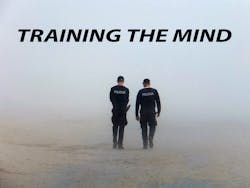It occurred to me that when someone reads my articles or those of another contributor, we often times use terminology that may not be understood fully and thus the thrust of the point gets lost. Therefore, I’ve chosen a couple of terms which are often used by police trainers, but which may be foreign to some.
I’d first like to explain what’s known as the OODA Loop. This concept was developed in the late 1950s by USAF Colonel John Boyd, a fighter pilot, and is therefore sometimes referred to as the Boyd OODA Loop, or simply the Boyd Loop. The system, when understood, allows one to act more quickly than your adversary by using an unconscious response. It accomplishes this feat by imprinting survival skills into your memory just like defensive tactics and firearm training, to name just two of the survival skills. Through repetition and interactive training, the mind and body work in tandem to reduce reaction time by building synapses between brain and cells. The reaction to danger, therefore, is encoded in long-term memory, minimizing reaction time and causing an almost instantaneous answer to a threat.
There are four parts to the OODA Loop: Observe, Orient, Decide, and Act. Knowing about the Loop helps one understand the decision making process in our brain. Reacting to and addressing a threat in law enforcement can mean the difference between winning and losing. Every confrontation, physical and verbal, is a battle for time. Whoever acts quickest usually wins, and bear in mind the bad guy is going through the same mental process. Hopefully, we have the advantage vis-à-vis our training.
Simplifying the Loop, we first Observe the situation or confrontation, we then Orient ourselves to it by maintaining our position or changing to a more tactical one based on the type of threat, next, we Decide on what we should do to control and win, and finally, we Act. However, the dynamic may change at any time causing a need to adapt—the process then begins anew. Through training, we develop and reinforce our OODA Loop. Remember the phrase, the way you train is the way you fight. And through repetitive training, just like with our survival skills, e.g. firearms and DT, our Loop becomes stronger.
Next, you may encounter in your reading, or someone may use the terms, condition white, yellow, orange or red. This color code system is the brainchild of Colonel Jeff Cooper, a former Marine and an expert on the use and history of firearms. In explaining his system, Cooper emphasized that the most important factor in survival is Mindset. That concept—a winning mindset—has been taught for decades by police trainers. Thus, the color codes refer to one’s state of mind.
The codes are:
- Condition White: relaxed, unaware and unprepared
- Condition Yellow: relaxed yet alert, aware that there is always the possibility a threat will materialize
- Condition Orange: Something has captured your attention and you must focus on the threat calculating the odds of the person triggering your reaction
- Condition Red: Fight. The threat has become reality and you immediately take action. Note that sometimes trainers will substitute Condition Black for Condition Red.
Interestingly, the four codes coincide with Boyd’s Loop of Observe (white), Orient (yellow), Decide (Orange), and Act (Red). By being aware of both the OODA Loop and Cooper’s Color Code System, through training you will be able to act and react quickly and thus increase your chance of winning.
Stay Safe, Brothers and Sisters!



